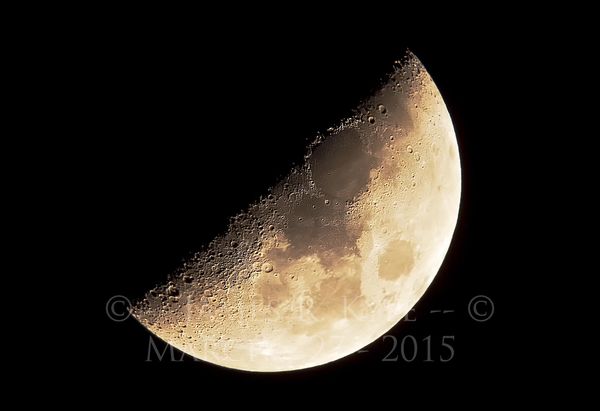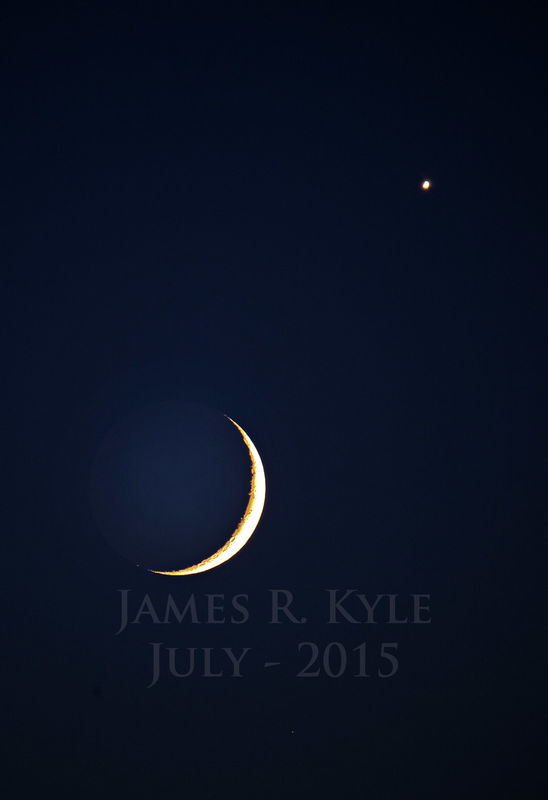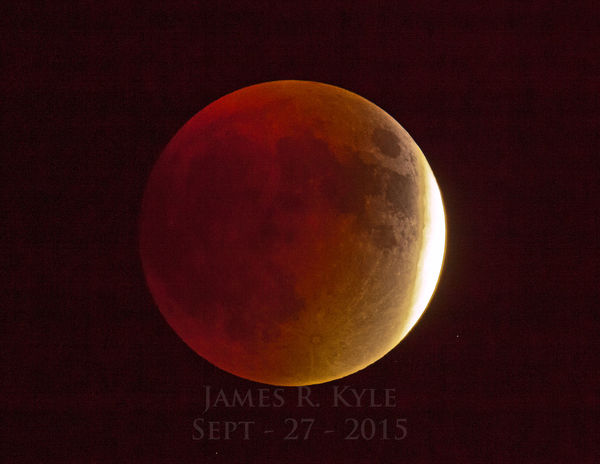Moon pics
Dec 14, 2016 14:43:49 #
I was trying to capture the moon last night and no matter what I tried, the picture was not coming out clear. The moon was just a bright fuzzy circle. Is there a special or specific way to do this? I was using Nikon D3400 70-300 lens. I used different settings and even guided settings but I could not capture it.
Thank you.
Thank you.
Dec 14, 2016 14:48:27 #
Dec 14, 2016 14:51:42 #
One of the things you need to understand when shooting the moon is that the moon is DAYLIGHT. You need to adjust the camera for a daylight setting. The problem is if you are shooting in the dark you will not have any foreground to add to the shot. Best to shoot just around dusk where there is still some ambient light. I am sure we have all experienced this problem one time or another. Sorry you lost you photo. There will not be another supermoon in many years...
Dec 14, 2016 14:54:28 #
Use the old standby LOONEY 11 RULE:
The “looney 11 rule” states that for astronomical photos of the Moon’s surface, set aperture to f/11 and shutter speed to the (reciprocal of the) ISO film speed (or ISO setting).”
With ISO 100, one sets the aperture to f/11 and the shutter speed to 1/100 or 1/125 second.
With ISO 200, aperture at f/11, set shutter speed to 1/200 or 1/250.
With ISO 400, aperture at f/11, set shutter speed to 1/400 or 1/500.
As blue-ultra mentioned, it's like shooting in the daylight -
If you search the net for moon photography you will find many articles with tips and tricks...
The “looney 11 rule” states that for astronomical photos of the Moon’s surface, set aperture to f/11 and shutter speed to the (reciprocal of the) ISO film speed (or ISO setting).”
With ISO 100, one sets the aperture to f/11 and the shutter speed to 1/100 or 1/125 second.
With ISO 200, aperture at f/11, set shutter speed to 1/200 or 1/250.
With ISO 400, aperture at f/11, set shutter speed to 1/400 or 1/500.
As blue-ultra mentioned, it's like shooting in the daylight -
If you search the net for moon photography you will find many articles with tips and tricks...
Dec 14, 2016 14:54:53 #
Thank you! Good point. Yeah I'm so sad. I'll just have to enjoy everyone else's pictures that I am seeing on the Internet.
Dec 14, 2016 14:56:51 #
Jelisa35 wrote:
I was trying to capture the moon last night and no matter what I tried, the picture was not coming out clear. The moon was just a bright fuzzy circle. Is there a special or specific way to do this? I was using Nikon D3400 70-300 lens. I used different settings and even guided settings but I could not capture it.
Thank you.
Thank you.
Probably an exposure issue. As stated, start in manual mode, ISO 400, f6.3, 1/160 sec. should give you a starting point.
Then vary according to taste.
If the circle is still fuzzy, make sure your autofocus is set to center spot.
W
Dec 14, 2016 14:58:24 #
Tonight the moon is still 99% full - you should be able to get some excellent shots -
The Moon & Night Calculator site is good to have: http://www.cambridgeincolour.com/tutorials/moon-night-calculator.htm?utm_source=newsletter&utm_medium=email&utm_campaign=news22
happy shooting...
The Moon & Night Calculator site is good to have: http://www.cambridgeincolour.com/tutorials/moon-night-calculator.htm?utm_source=newsletter&utm_medium=email&utm_campaign=news22
happy shooting...
Dec 14, 2016 15:04:32 #
Shellback wrote:
Tonight the moon is still 99% full - you should be able to get some excellent shots -
...happy shooting...
...happy shooting...
Of course, depending on where you are, you will probably freeze your
 off ....
off ....Dec 14, 2016 16:02:17 #
If you are using live view you should see more moon details as you raise your shutter speed. Set iso manual at iso-100 as other said. Zoom out to 300mm. You can start at f8 and take some pics at a higher and lower f stop to see if it makes a difference. You should get a decent pic with decent details if that is what you see in live view on the lcd screen. Until the camera can see the details of the moon, it has nothing to focus on, just a blob of white light.
Dec 15, 2016 05:43:25 #
I've shot the moon many times before (and published some of them here) but i had the same problem last night. I tried several settings, focusing on the rear screen x10, tripod and cable release etc. but nothing came out really clear and sharp.
I used a CANON 60D + 400mm F5.6 'L' lens.
There was a little wind on an exposed escarpment and I felt the chill. Just maybe I was tearing up a little and this misted my perception of being in focus.
The upside was my planning, getting a food location to see the moon rise above the escarpment 40° off North worked a treat and visually it was a bonanza. I just didn't do it it justice.
I used a CANON 60D + 400mm F5.6 'L' lens.
There was a little wind on an exposed escarpment and I felt the chill. Just maybe I was tearing up a little and this misted my perception of being in focus.
The upside was my planning, getting a food location to see the moon rise above the escarpment 40° off North worked a treat and visually it was a bonanza. I just didn't do it it justice.
Dec 15, 2016 06:59:31 #
("Try manual mode, f/11, s100, ISO 100"
That's about the best straight forward advice... but use a tripod and set the shutter timer at 5 or ten seconds. that was there's no movement at all. i also get better shots if i turn of the VR. if your lens has it.
That's about the best straight forward advice... but use a tripod and set the shutter timer at 5 or ten seconds. that was there's no movement at all. i also get better shots if i turn of the VR. if your lens has it.
Dec 15, 2016 07:13:14 #
I would like to add that the moon is moving so the faster shutter speed you can use is probably a good thing to mention also avoid camera shake (tripod) and turn off image stability.
Dec 15, 2016 09:17:37 #
Capturing images of the moon can be a bit trying. Use a tripod (A GOOD one) ((REMEMBER to Turn OFF the Image Stabilizer)) - set the camera to Manual - Manual focus by making use of the L.C.D. screen and Magnify ten Times (10X) - ((Remember the earth revolves so you have to focus and reposition the camera to anticipate where the moon will be in the frame.)) Take many shots, Bracket the exposures - You can do this = anyone can if I can. (I have the first stage of Parkinson's - so I know that anyone can do this -- :-) ))
attached are photos that I have captured.....
attached are photos that I have captured.....
Dec 15, 2016 09:29:22 #
I simply use spot metering and focus directly on the moon. All the moon's details will be properly exposed. If I want to pull out more detail in the surrounding area, I'll use LR in post processing. It's easier with my Fuji XT-2 mirrorless than with my Nikon D750 because I can see the actual exposure in the EVF. But you can also use Live View with a traditional DSLR.
Dec 15, 2016 10:00:39 #
You've gotten much good advice on correct moon exposure but be aware that the "super" moon is not visibly larger than a regular old moon. Yes, it is larger but so slight your camera won't notice the difference. The first mention of a "super" moon that I remember was about 2 years ago. As the moon orbits the earth it is sometimes closer and sometimes further away which has been happening forever. A couple of years ago a "news guy" got wind that the moon would be at one of it's closer points during a full moon and gave birth to the "super moon" title. As a photographer all you need is a clear night, don't wait another 30 something years.
If you want to reply, then register here. Registration is free and your account is created instantly, so you can post right away.















